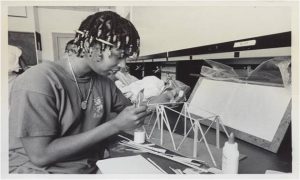Dr. Aprille Ericcson, a 1980 alumna of MITES, is Deputy to the Chief Technologist at NASA’s Goddard Space Flight Center.
Seventeen-year-old Aprille Ericsson strapped into the flight simulator at Hanscom Air Force Base in Bedford, Massachusetts, while taking part in MIT’s Minority Introduction to Engineering and Science (MITES) in 1980 during the summer before her senior year. A talented student from Brooklyn expecting to pursue a law degree, this was her closest experience to piloting an aircraft. An affinity for aerospace was born when she stepped out of the simulator and saw her score –103, just three points from perfect. “That was my first real interest in aeronautics and astronautics,” she says. Since taking part in MITES, Ericsson has held several positions in the aerospace industry, including her current job as Deputy to the Chief Technologist at NASA Goddard Space Flight Center. Now, she works to identify gaps in technology and enable researchers to fulfill those future technological needs.
Ericsson’s high school algebra teacher, also an MIT alum, recommended the MITES program, formerly UNITE, which she later attended. The program today runs for six weeks in June and July and gives engineering and science-inclined students the chance to experience life and college-level courses at MIT during the summer between their junior and senior years. While on campus, MITES students create meaningful networks of friends and staff, and most MITES alumni go on to study science and engineering at top universities. Ericsson pursued her undergraduate degree at MIT and her graduate study at Howard, where she became the first African American woman to receive a Ph.D. in Mechanical Engineering at the university.
During MITES, Ericsson learned about her growing desire to help people and found fellow students who shared her excitement for learning. The combination of intrinsically motivated students and encouraging instructors and teaching assistants gave her confidence to enter the aerospace field. “The people supporting the Office of Engineering Outreach Programs are really bright people I still admire,” says Ericsson.
MITES also taught Ericsson how to handle crises. During a bridge building competition, she injured her finger while feverishly trying to finish the project. “I learned to work under duress, in short periods of time. I learned to accomplish things and put my mind to it,” says Ericsson. Despite her injury, she was able to return and finish her bridge for the competition. The ability to thrive under strict time constraints and stressful situations was a critical skill she developed at MITES. Under the inspiration of MITES, Ericsson attended MIT a year later.
 In July 1980 during MITES, Ericcson learned to work in high pressure scenarios during a bridge building competition.
In July 1980 during MITES, Ericcson learned to work in high pressure scenarios during a bridge building competition.
After MITES and MIT, Ericsson entered the workforce and found a series of fulfilling positions. “I find it particularly enticing to improve people’s lives and make them easier,” says Ericsson. “The projects that I work on have to be impactful in our communities. They have to be positive and not destructive.” Instead of working on missile defense, Ericsson attended graduate school at Howard University, where she developed control algorithms for applications like the International Space Station. While a Ph.D. intern, she joined the ranks of the NASA Goddard Space Flight Center, creating methods of attitude control simulation and software testing.
Along with creating useful technologies that benefit people on a larger scale, Ericsson enjoys the thrill of solving complex problems. “When you’re trying to obtain a goal, you don’t know how many steps you’ll need to take,” says Ericsson. “Spending an entire lifetime on helping to solve questions and problems is really cool.”
Ericsson has also devoted herself to empowering young women and minorities interested in STEM careers. She has done this though active membership in the NASA GSFC Speakers Bureau as a Mentor and University Professor, and previously as an aerospace teacher for students at Howard University Public Charter Middle School of Math & Science.
Ericsson advises aspiring scientists and engineers to maintain high hopes for the future and seek out opportunities with patience and perseverance. “The prizes of life are at the end of each journey,” she says. “Have lofty goals, believe in them and you will achieve them. You will always get there, but you will achieve a lot more than you thought you would.”